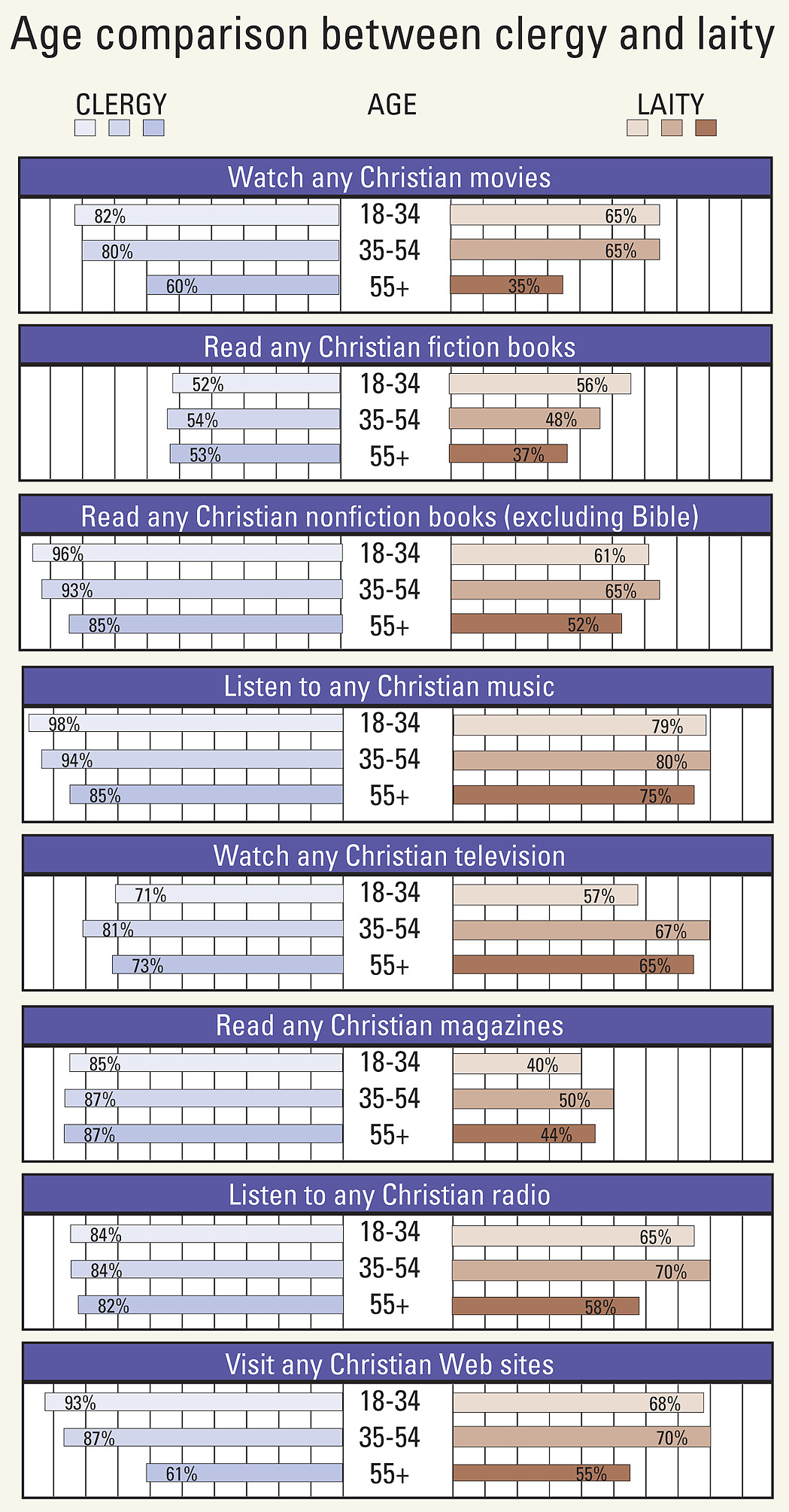
NASHVILLE, Tenn. (BP)–Research results being released for the first time in the July/August edition of Facts & Trends magazine show most people who attend a Protestant church are using Christian media — magazines, websites, television, radio, movies and music — but that Christian media is only a fraction of the media churchgoers use.
Protestant clergy, on the other hand, are much heavier users of Christian media than are the people in their churches.
Facts & Trends is published bimonthly by LifeWay Christian Resources of the Southern Baptist Convention.
Two studies were conducted for Facts & Trends by Ellison Research of Phoenix, Ariz. One was a representative sample of 806 Protestant church ministers nationwide, and the other was a companion survey of 1,184 adults who attend Protestant churches at least once a month. Respondents were asked about their media use, including use of “specifically Christian” media (not just media with good values or an “inspirational” message).
The study showed Christian media is commonly used by Protestant laity:
— 78 percent listen to Christian music.
— 64 percent watch Christian television.
— 64 percent visit Christian websites.
— 64 percent listen to Christian radio.
— 60 percent read Christian non-fiction books.
— 55 percent watch Christian movies.
— 47 percent read Christian fiction books.
— 44 percent read Christian magazines.
Yet for each type of media, the average proportion dedicated to Christian options is less than half –- usually much less than half. The proportion of media use that is specifically Christian ranged from a high of 42 percent for music (meaning on average, 42 percent of all music Protestant churchgoers listen to is Christian) to a low of 17 percent for movies.
And it is rare for Christians to rely solely on the Christian genre of any of the various media types. Music scored highest, but only 7 percent in the survey who listen to music listen solely to Christian music.
There are numerous differences by denominational groupings. While Southern Baptist churchgoers are fairly average in their media use, people who attend other types of Baptist churches (for example, independent Baptist, General Baptist, Regular Baptist) are particularly heavy consumers of Christian fiction and Christian radio. People from Pentecostal or Charismatic denominations are more likely than average to use Christian fiction, magazines, websites, and particularly radio and music.
Protestant churchgoers from mostly mainline denominational groups are, on average, lighter consumers of Christian media. Methodists are relatively light users of Christian books, radio, music, and websites. Lutherans are comparatively infrequent consumers of Christian films, fiction, music and radio. Presbyterians are the denominational group least likely to listen to Christian radio.
Ron Sellers, president of Ellison Research, said the research shows what the business community has known for some time — Christian media is big business with a wide reach.
“Secular corporations have been backing movies with strong religious themes, buying Christian publishing companies, and releasing albums from Christian artists, and these figures really show why,” Sellers said. “Christian media, although often still lacking the financial resources of the secular media, is reaching tens of millions of Protestant churchgoers and clergy on a regular basis — to say nothing of its reach among people who don’t attend Protestant churches.”
Lay leaders within churches tend to use Christian media much more than do non-leaders. For example, 58 percent of all lay leaders read Christian magazines, compared to 39 percent among those who are not in a leadership position. Christian magazines account for an average of 28 percent of the magazine reading lay leaders do, versus 17 percent among non-leaders.
Clergy use Christian media even more than lay leaders. Among Protestant clergy:
— 94 percent listen to Christian music.
— 92 percent read Christian non-fiction books.
— 87 percent read Christian magazines.
— 84 percent listen to Christian radio.
— 83 percent visit Christian websites.
— 77 percent watch Christian television.
— 76 percent watch Christian movies.
— 53 percent read Christian fiction books.
Plus, among clergy, Christian media tends to represent a higher proportion of media usage than it does among laity. On average, 45 percent of the fiction books read by clergy are Christian fiction (28 percent among laity), 66 percent of the music clergy listen to is Christian (42 percent among laity) and 51 percent of the websites ministers visit are Christian (20 percent among clergy). Only Christian television showed no difference in use between pastors and laity.
Like churchgoers, among clergy there are significant differences in media use according to denominational groupings. Southern Baptist ministers are particularly heavy users of Christian radio and movies. Clergy from other Baptist denominations are also more likely than average to listen to Christian radio. Pentecostal and Charismatic pastors also rely more than average on Christian music.
Lutheran pastors read less Christian fiction, listen to less Christian music and radio, and watch less Christian TV than average. Presbyterian ministers consume less Christian television and radio. Methodists are fairly average in their media use. Overall, evangelical pastors tend to be heavier consumers of Christian media than are mainline Protestant ministers; evangelicals are heavier users of Christian fiction, music, magazines and radio than are mainline pastors.
Sellers said there is still tremendous room for growth within Christian media.
“Although Christian media of some type reaches the vast majority of Protestants, for the average person it still represents a fraction of the media they consume. From a pure business standpoint, in most categories there is probably greater growth potential in getting current Christian media consumers to consume more of it than to try to convert non-users to users.”
–30–















